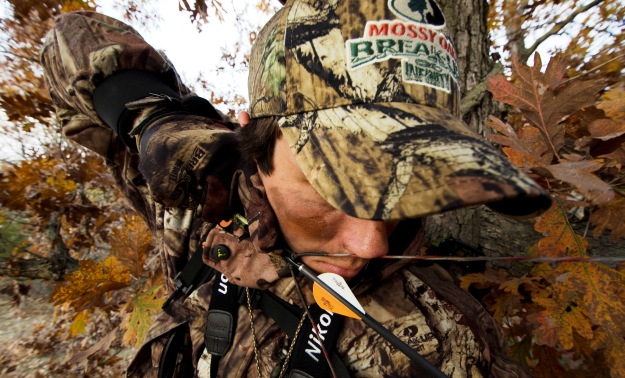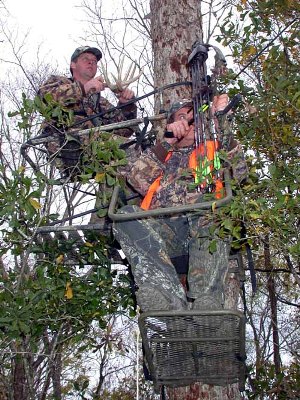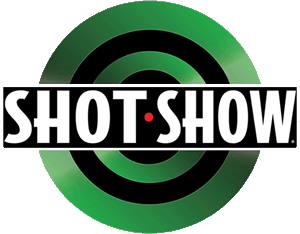
Editor’s Note: Ronnie “Cuz” Strickland, today the vice president of Mossy Oak in charge of television and video production, may have filmed more TV shows and videos about hunting and the outdoors than anyone in the industry. Currently Cuz is responsible for producing these TV shows, including “Hunting the Country,” “Deer Thugs,” “Turkey Thugs,” “Inside the Obsession” and “GameKeepers,” as well as all the videos that Mossy Oak produces. A growing number of sportsmen who hunt together trade off between being the videographer and being the hunter. Good video cameras are less expensive today than they ever have been, besides being smaller, lighter and easier to use. Often today hunters don’t tell the stories of their hunts to friends and family but instead show the videos of their hunts. To provide this new breed of video hunters and shooters with the best information available, we’ve asked Ronnie Strickland to tell us how to avoid the most-common mistakes that most video hunters make, when they’re trying to film a hunt.
In football, coaches tell their players that football is a game of inches. When you’re trying to video a hunt, you also have to remember that good video is also a game of inches. Many times, we forget that all hunters aren’t the same size. If you’re hunting with someone who is 5’11”, the field producer’s camera has to be lower than he normally may have it. If the hunter is 6’6”, then if the field producer doesn’t move his camera higher than he normally will, he’ll be videoing the back of the hunter’s head. Although this seems like an easy adjustment to make, the cameraman’s excuse is always, “Well, I set up my stand at the same height above the hunter that I always do.” The cameraman often forgets that his stand has to be adjusted to the height of the hunter he’ll be videoing. This problem is seen most dramatically, when a person with a camera hunts with a variety of different hunters.
 Whether the hunter is planning to stand-up and shoot, or will shoot from a sitting position is another element that drastically affects the video. If I am videoing a hunter, who is planning to stand-up to shoot, after I think I have my stand in the right position, I’ll ask the hunter to get in his stand and stand-up like he will when he’s shooting. Then I adjust my stand to allow the camera to look right over the top of the shooter’s head. The worst words that a hunter can hear, when he has an animal within range is: “PSSST, don’t shoot. All I can see is the back of your head.” That mistake is not the hunter’s fault, but rather is the cameraman who hasn’t set-up correctly to get the shot. For this reason, if you are going to shoot good video, you have to make sure you adjust the position of your tree stand for that individual hunter. Then you’ll see what he sees, and the hunter doesn’t block your view.
Whether the hunter is planning to stand-up and shoot, or will shoot from a sitting position is another element that drastically affects the video. If I am videoing a hunter, who is planning to stand-up to shoot, after I think I have my stand in the right position, I’ll ask the hunter to get in his stand and stand-up like he will when he’s shooting. Then I adjust my stand to allow the camera to look right over the top of the shooter’s head. The worst words that a hunter can hear, when he has an animal within range is: “PSSST, don’t shoot. All I can see is the back of your head.” That mistake is not the hunter’s fault, but rather is the cameraman who hasn’t set-up correctly to get the shot. For this reason, if you are going to shoot good video, you have to make sure you adjust the position of your tree stand for that individual hunter. Then you’ll see what he sees, and the hunter doesn’t block your view.
Here’s another problem that can happen when shooting hunting video. The field producer will be panning from left to right, just as the hunter comes to full draw. When the hunter’s at full draw, with his bow ready to take an animal, the worst sound he’ll ever hear in his life is, “PSSST, you’re blocking my shot.” If you’ll set-up to get the shot with the camera just over the hunter’s head, you’ll get good video and have a happy hunter. One of the questions I’m most often asked after I have explained where to position the videographer’s tree stand for both the sitting shot and the standing shot is: “What do I do, if the hunter says, ‘I don’t know if I am going to take the shot sitting or standing.’” If your hunter doesn’t know whether he’ll take the shot sitting or standing, have him stand-up and position your camera, so you can video over the top of his head, if he stands up. Then, if he takes the shot seated, you should at least have a clear view of the animal, before the hunter squeezes the trigger or releases the arrow.
To get good hunting video, the hunter and the field producer have to learn to dance together. Each one of the two partners has to anticipate the moves of the other. So, if the opportunity presents itself, the flow of the action is like two dancers moving at the same time, to the same song, with the same beat.
Day 2: The Camera Squeak That Lives
Tomorrow: Using Automatic Focus on a Camera is the Kiss Of Death for the Videographer



























